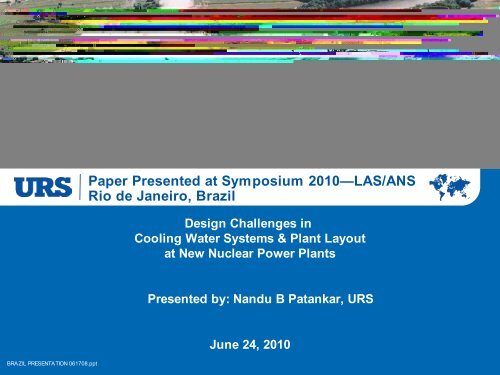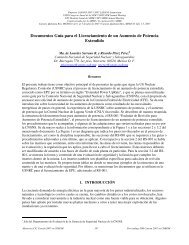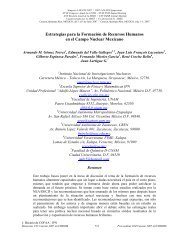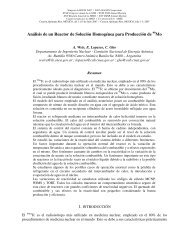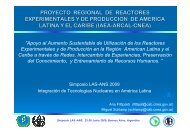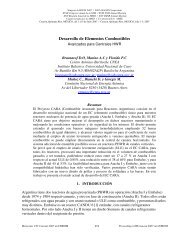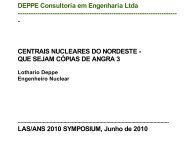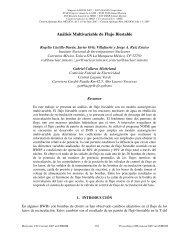Design Challenges in Cooling Water Systems - LAS-ANS
Design Challenges in Cooling Water Systems - LAS-ANS
Design Challenges in Cooling Water Systems - LAS-ANS
Create successful ePaper yourself
Turn your PDF publications into a flip-book with our unique Google optimized e-Paper software.
Paper Presented at Symposium 2010—<strong>LAS</strong>/<strong>ANS</strong>Rio de Janeiro, Brazil<strong>Design</strong> <strong>Challenges</strong> <strong>in</strong>Cool<strong>in</strong>g <strong>Water</strong> <strong>Systems</strong> & Plant Layoutat New Nuclear Power PlantsPresented by: Nandu B Patankar, URSBRAZIL PRESENTATION 061708.pptJune 24, 2010
<strong>Design</strong> <strong>Challenges</strong> <strong>in</strong> Cool<strong>in</strong>g <strong>Water</strong> <strong>Systems</strong>– New Nuclear Power Plants UNIQUE REGULATORY DIFFERENCES BETWEEN US & OTHERCOUNTRIES US DESIGNUS CLEAN WATER ACT PRECLUDES THE DESIGN OF “ONCE-THROUGHCOOLING WATER SYSTEM” FOR COOLING WATER SYSTEMSTHIS IS MAINLY TO PROTECT AQUATIC LIFE & REGULATE THE DESIGN OFCOOLING WATER SYSTEMRULE 316(b) – INTAKE STRUCTURE REQUIREMENTSMAKING THE DESIGNS VERY COSTLY DESIGN IN OTHER PARTS OF THE WORLDABOVE REGULATION IS NOT APPLICABLE“ONCE-THROUGH COOLING WATER SYSTEM” SHOULD BE APPLIED, ASAPPROPRIATECopyright © 2010 URSPow erCONFIDENTIAL – This document is proprietary and competitively sensitive. Any disclosure, copy<strong>in</strong>g, or use of it is strictly prohibited.4
<strong>Design</strong> <strong>Challenges</strong> <strong>in</strong> Cool<strong>in</strong>g <strong>Water</strong> <strong>Systems</strong> DESIGN & LICENSING BASIS LOCATION & ORIENTATION WATER TEMPERATURES & DISCHARGE LIMITS APPROACH TEMPERATURE CYCLES OF CONCENTRATION METEOROLOGICAL DATAWET BULB TEMPERATUREWINDCopyright © 2010 URSPow erCONFIDENTIAL – This document is proprietary and competitively sensitive. Any disclosure, copy<strong>in</strong>g, or use of it is strictly prohibited.5
<strong>Design</strong> <strong>Challenges</strong> / Considerations <strong>in</strong> Site Plant Layout Orientation of the Turb<strong>in</strong>e Island with respect to the water source for Open /Closed Loop Cool<strong>in</strong>g, Cool<strong>in</strong>g Tower, Pond or Reservoir arrangement for CWS Location of the Turb<strong>in</strong>e Build<strong>in</strong>g (Generator end) to be <strong>in</strong> close proximity to theswitchyard Location of the plant switchyard <strong>in</strong> relation to exist<strong>in</strong>g transmission l<strong>in</strong>es andpotential transmission <strong>in</strong>terconnection po<strong>in</strong>ts M<strong>in</strong>imum spac<strong>in</strong>g between units for a two-unit power plant (distance betweenreactor vessel center l<strong>in</strong>e to center l<strong>in</strong>e) Construction Plot Plan: Location of crane, lay down space, concrete batch plant,modular fabrication, construction offices, potential borrow areas, spoils area,construction access road, park<strong>in</strong>g, etc. Establish<strong>in</strong>g site flood<strong>in</strong>g & dra<strong>in</strong>age maps (<strong>in</strong>clud<strong>in</strong>g site topography) Establish<strong>in</strong>g site grade to m<strong>in</strong>imize site cut and fill Assess<strong>in</strong>g the plant rock quality and depth (conduct sufficient bor<strong>in</strong>g)Copyright © 2010 URSPow erCONFIDENTIAL – This document is proprietary and competitively sensitive. Any disclosure, copy<strong>in</strong>g, or use of it is strictly prohibited.6
<strong>Design</strong> <strong>Challenges</strong> / Considerations <strong>in</strong> Site Plant Layout(Cont’d) Identify<strong>in</strong>g any exist<strong>in</strong>g below grade structures and/or utilities (water,sewerage, power l<strong>in</strong>es) that could potentially impact plant layout Identify overhead limitation—transmission l<strong>in</strong>es and right of way Identify plant access roadways dur<strong>in</strong>g construction phase and when theplant is operat<strong>in</strong>g Identify support<strong>in</strong>g structures such as adm<strong>in</strong>istration build<strong>in</strong>g, securitybuild<strong>in</strong>g, ma<strong>in</strong>tenance build<strong>in</strong>g, warehouses, tra<strong>in</strong><strong>in</strong>g center, etc. Identify security requirements dur<strong>in</strong>g construction especially if at a sitewith an operat<strong>in</strong>g unit. Recommendation is to prepare two site layouts: <strong>Design</strong> Layout &Construction LayoutCopyright © 2010 URSPow erCONFIDENTIAL – This document is proprietary and competitively sensitive. Any disclosure, copy<strong>in</strong>g, or use of it is strictly prohibited.7
<strong>Design</strong> <strong>Challenges</strong> <strong>in</strong> Cool<strong>in</strong>g <strong>Water</strong> <strong>Systems</strong> & PlantLayout – New Nuclear Power Plants SUMMARY EACH OF THE NEW NUCLEAR PLANT TECHNOLOGIES HAVEUNIQUE TECHNICAL REQUIRMENTS FOR COOLING WATERSYSTEMS (Ref: DCD & COMBINED OPERATING LICENSEAPPLICATION) PLANT LAYOUT HAS MANY DESIGN & CONSTRUCTIONCONSIDERATIONS THAT SHOULD BE CAREFULLY EVALUATED,ESPECIALLY AT EXISTING NUCLEAR SITES ENVIRONMENTAL & STATE / LOCAL REGULATIONS SHOULD BEADDRESSED DEPENDING ON THE COUNTRY WHERE THE NEWNUCLEAR PLANT WILL BE BUILTCopyright © 2010 URSPow erCONFIDENTIAL – This document is proprietary and competitively sensitive. Any disclosure, copy<strong>in</strong>g, or use of it is strictly prohibited.8


